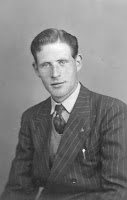Case Studies in Murder III - The Last Protestant
Garrison is a small village in rural Co Fermanagh close to the border with Co Leitrim in the Republic of Ireland. It obtained its name after a barracks was erected there by the Williamite forces following the Battle of Aughrim. Despite its connection to the iconic period of Orange history Garrison was and remains a strongly Republican village, something underscored by the fact that under the aborted proposals of the Irish Boundary Commission in 1925 it would have been transferred from Northern Ireland to the Irish Free State. There was, nonetheless, a small Protestant population in the village in the 1970s.
The events of 1st March 1972 were to change that.
Thomas Fletcher, known as Johnny, was a forestry worker as well as working a small 20-acre farm which straddled the border. He had married 3 years previously. Johnny enjoyed shooting and darts, a sport in which his left handedness resulted in some comment. He was also a part time member of the Ulster Defence Regiment.
Around 8am he was leaving home for work when four men wearing stocking masks and carrying guns stopped him when he came to the gate across his lane. They took him back to the farmhouse where they were able to steal his pistol and shotgun.
The men then advised his wife that they were taking him hostage so that they could make it over the border with the firearms: “He will not be harmed. We want to show him across the river”.
They proceeded to frogmarch Johnny to a field some 150 yards away. As his wife watched they fired multiple times killing him instantly before strolling off over the border.
The RUC believed that Johnny Fletcher’s movements had been watched for some time and that the murder was probably weeks in the planning.
The funeral took place two days later during a violent snowstorm. Slates were blown off the roof of Garrison Parish Church as the service was taking place inside. Driving hail and snow lashed the mourners and a UDR firing party as they later stood around the grave.
One of those shivering on the cemetery hillside was a neighbour of Johnny Fletcher, John McClure. The weather conditions must have felt like an ominous portent should he remain in his home. In 1999 he recounted what happened to a reporter from the Guardian:
Two days after carrying his friend's coffin, Mr McClure fled the small border community of Garrison with his wife Ivy, and their five children, aged twelve to three, and went to live in Churchill. It was a run-down house, without a lavatory. The three other Protestant families then living in Garrison decided to go too. There were no problems with their Catholic neighbours, but threats were coming thick and fast from the IRA just south of the border.
Mr McClure was a member of the recently founded Ulster Defence Regiment. He netted at most £20 a month and had joined out of duty. So, too, had Johnny Fletcher. Mr McClure knew it could just as easily have been him executed and dumped on the River Kilcoo.
When he and Ivy left the home where their children were born, they thought they would be back soon, that the Troubles would be over.
Instead, they moved several times, scrimping to improve the houses. Mr McClure took work as a lorry driver.
They live now in Springhill, 18 miles from Garrison, and would love to return to the 100-acre farm.
The three-bedroom bungalow is a ruin these days. A horse bridle lies in the middle of the floor; an old radio and tilly lamp to the side. Still hanging from one door is Ivy McClure's coat, mildewed. They had left in a hurry.
None of the families who fled their farms in the aftermath of the Fletcher murder received any government compensation.
Three years later, on 1st June 1975, Margaret Kilfedder and her husband Samuel were sleeping in their home close to the village. They had, ironically, moved to the Garrison area from Belfast to get away from the violence.
Lost Lives quotes Samuel Kilfedder’s account of what happened that night after he was wakened by a blinding white flash followed by an explosion:
“The bedroom wall came in round us. I freed myself from the rubble and attempted to remove concrete slabs from on top of my wife but could not. Then I ran for help. I pulled on some clothes and ran down the lane in my sock soles for help. Several cars passed me before a man I know came along and took me to a house with a telephone so that I could call for help.”
The explosion was caused by a cylinder bomb.
Like the Fletcher murder, the murder of the mother of five was never claimed although no one seriously questioned that the PIRA, the only terrorist group active in the area as other events like the murder of bread delivery man Jack McClenaghan in 1979 shows, were responsible.
On the other side of Co Fermanagh there were not dissimilar events in the village of Rosslea which also lies on the border with the Republic of Ireland.
In previous decades there were three shops owned by Protestants in Rosslea, a fourth man working in the egg industry and a Protestant owned sawmill so there were approximately five Protestant owned businesses in the village.
By May 1977 Douglas Deering was the last Protestant shopkeeper left in the village he was born in 53 years previously and in which he had raised three children. As a member of the Brethren it is quite possible that Mr Deering, like many members of that religious community, would have objected to even being described as a Protestant. While subscribing to many of the core Reformation doctrines the Brethren reject denominational structure and usually prefer simply to be referred to as Christians. To this day many would seek to avoid being “pigeonholed” into one of Northern Ireland’s “tribes” with many, perhaps the majority, making a point of not engaging in the political process even by voting.
Deering attended a Gospel Hall across the border in Clones and was active in a small Brethren group in the Rosslea area where he taught Sunday school.
Unlike other businesses in the village, his shop served members of the security forces and had been bombed no less than four times but he refused to leave.
A girl who worked in the shop described what happened on 12th May 1977 after she went outside to supply petrol to a car which had pulled up with three men inside. Two men got out and went into the shop: “I heard two shots and saw the two men running out. One man had a small gun in his hand. I rushed back to the shop and saw Mr Deering lying on the floor.”
She sent for the local doctor but the shop owner was dead by the time he arrived.
Mrs Deering, who was in Enniskillen at the time of her husband’s murder, was stopped by police on the way home to be told what had happened.
Again the murder wasn’t claimed. In fact, the PIRA pointed out that Douglas Deering had kept his shop open in defiance of the 1977 loyalist strike and contended that he had therefore been murdered by loyalists in the Republican village which had no loyalist population much less a history of loyalist violence.
What do these events in South Fermanagh in the 1970s tell us about the PIRA campaign?
The tactical advantage to the PIRA of having an area round the border free of people they suspected of being sympathetic to the security forces is obvious.
Incidents such as those recounted above have resulted in claims of ethnic cleansing in Co Fermanagh. Whether that phrase is strictly applicable given that there are internationally agreed definitions of what constitutes ethnic cleansing is a question I plan to return to. What cannot be disputed in the cases of Margaret Kilfedder and Douglas Deering is that the murders were blatantly sectarian.
The nature of Johnny Fletcher’s murder was also clearly designed to send a message to the local Protestant community and it is telling that his neighbours hadn’t returned to their farm two decades later.
It is important to remember that throughout their campaign the PIRA claimed that they were not sectarian. Their “war" was against the "British presence in Ireland", not Protestants. Loyalist terrorists on the other hand were openly sectarian. Gusty Spence, for example, infamously described the attitude of groups such as his UVF as "if you couldn't get an IRA man you should shoot a Taig”. The PIRA liked to claim that they were above such grubby sectarianism.
One of ways they sought to maintain that fiction was by simply not claiming murders such as those discussed above.
A note on sources
To compile this blogpost I have drawn on material from the sources listed below.
Constabulary Heroes 1826-2009: Incorporating RUC GC/PSNI by Sam Trotter
Lost Lives by David McKittrick et al.
South East Fermanagh Foundation Facebook page
|






Comments
Post a Comment